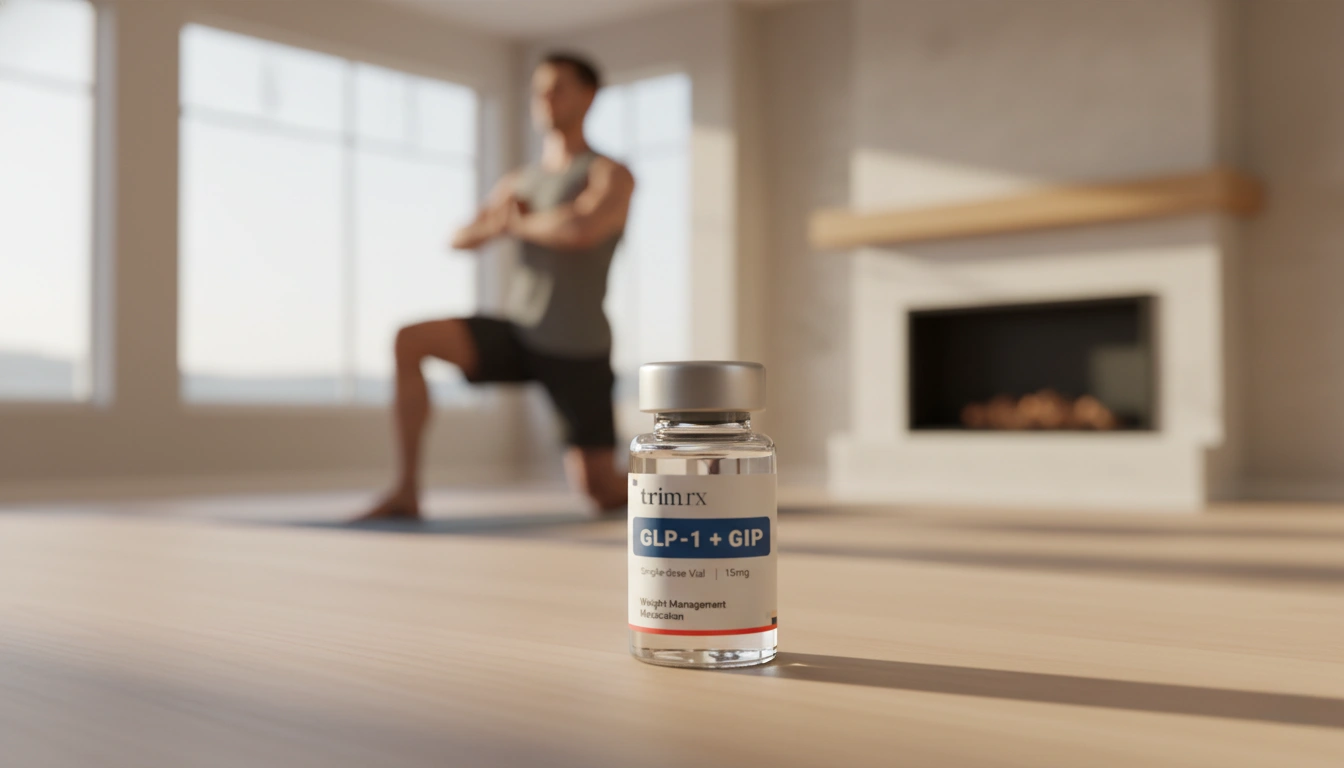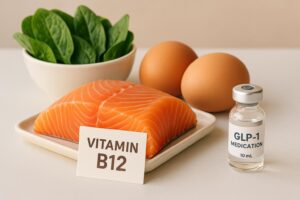How to Stimulate GLP-1 Naturally for Better Health

Introduction
Did you know that a single hormone in our body plays a crucial role in regulating appetite, blood sugar levels, and even weight management? This hormone, known as glucagon-like peptide-1 (GLP-1), is produced in our intestines and released after we eat. Its significance has gained traction recently, especially with the rise of medications that mimic its effects for weight loss and diabetes management. But what if we could stimulate GLP-1 naturally through our diet and lifestyle choices?
As we dive into this topic, we’ll explore how GLP-1 functions, its importance in our metabolic processes, and practical strategies to stimulate its production through natural means. By the end of this blog, you will have a comprehensive understanding of how to enhance GLP-1 levels naturally, which can lead to better appetite control and metabolic health.
We will cover the following aspects:
- The role of GLP-1 in the body
- Dietary components that stimulate GLP-1 release
- The impact of lifestyle factors and exercise on GLP-1 production
- Practical tips for incorporating GLP-1 boosting strategies into your daily routine
- How TrimRx’s personalized programs can support your weight management journey
Let’s embark on this journey together as we uncover how to stimulate GLP-1 naturally!
Understanding GLP-1: The Hormone Behind Appetite Regulation
GLP-1 is a hormone produced in the gut that serves multiple functions, primarily focused on glucose metabolism and appetite regulation. It is released in response to food intake, signaling the pancreas to release insulin, which helps lower blood sugar levels. Additionally, GLP-1 slows gastric emptying, meaning food stays in the stomach longer, promoting a sense of fullness.
Key Functions of GLP-1:
- Boosts Insulin Production: GLP-1 stimulates the pancreas to release insulin when blood sugar levels rise, which is crucial for maintaining healthy glucose levels.
- Slows Digestion: By delaying gastric emptying, GLP-1 helps to moderate the rate at which food enters the bloodstream, preventing spikes in blood sugar.
- Reduces Hunger: The hormone sends signals to the brain indicating satiety, helping curb appetite and reduce overall food intake.
- Controls Glucagon Release: GLP-1 inhibits the secretion of glucagon, a hormone that raises blood sugar levels, further assisting in blood sugar regulation.
Given its significant role in managing weight and diabetes, understanding how to enhance GLP-1 levels naturally becomes essential, especially as many individuals are seeking effective weight management strategies.
Dietary Approaches to Stimulate GLP-1
Our diet plays a pivotal role in the natural stimulation of GLP-1 secretion. Certain foods can effectively trigger the release of this important hormone, helping enhance feelings of fullness and regulate appetite.
1. High-Fiber Foods
Fiber is a key player in the stimulation of GLP-1. When we consume fiber-rich foods, our gut bacteria ferment the fiber, producing short-chain fatty acids (SCFAs) that can stimulate GLP-1 production.
Foods to Include:
- Whole Grains: Foods like oats, barley, and brown rice are excellent sources of soluble fiber, which can enhance GLP-1 release.
- Fruits and Vegetables: High-fiber fruits such as apples, pears, and vegetables like broccoli and carrots provide essential nutrients while promoting GLP-1 production.
- Legumes: Beans, lentils, and chickpeas are not only high in fiber but also provide protein, making them a great addition to your diet.
2. Protein-Rich Foods
Protein consumption has been shown to significantly influence GLP-1 secretion. When proteins are digested, they are broken down into amino acids, which can stimulate GLP-1 release.
Protein Sources to Consider:
- Eggs: Rich in protein and healthy fats, eggs can trigger GLP-1 secretion, helping to create a lasting feeling of fullness.
- Lean Meats: Chicken, turkey, and fish are excellent lean protein sources that can enhance GLP-1 levels.
- Dairy Products: Greek yogurt and cottage cheese are protein-rich options that can also support GLP-1 production.
3. Healthy Fats
Not all fats are created equal. Unsaturated fats, particularly those found in plant sources, can stimulate GLP-1 release more effectively than saturated fats.
Healthy Fat Sources:
- Nuts and Seeds: Almonds, walnuts, and chia seeds are not only nutritious but can also promote GLP-1 secretion.
- Avocado: High in fiber and healthy fats, avocados can help sustain GLP-1 levels.
- Olive Oil: This heart-healthy oil enhances GLP-1 release, making it a great choice for cooking or dressing salads.
4. Fermentable Dietary Fibers
Fermentable fibers are particularly effective at increasing GLP-1 levels. These fibers can be found in various foods and are broken down by gut bacteria into SCFAs.
Fermentable Fiber Sources:
- Barley and Oats: Both are rich in beta-glucan, a type of soluble fiber that has been shown to elevate GLP-1 levels.
- Chicory Root: Often used as a dietary supplement, chicory root is high in inulin, a fermentable fiber that promotes GLP-1 secretion.
- Beans and Lentils: The soluble fiber in legumes can significantly impact GLP-1 levels.
The Role of Lifestyle in GLP-1 Production
In addition to dietary adjustments, certain lifestyle changes can further help stimulate GLP-1 production, enhancing overall metabolic health.
1. Regular Physical Activity
Exercise is not only beneficial for weight management but also plays a role in increasing GLP-1 levels. Research indicates that both aerobic and resistance training can enhance GLP-1 secretion.
Recommendations:
- Aim for at least 150 minutes of moderate-intensity exercise each week, coupled with two days of strength training.
- Activities like walking, cycling, swimming, and weight lifting are great options to incorporate into your routine.
2. Stress Management
Chronic stress can negatively impact our hormonal balance, including GLP-1 levels. Managing stress through mindfulness practices, yoga, or deep breathing exercises can help maintain a healthy hormonal environment.
3. Quality Sleep
Adequate sleep is crucial for hormone regulation. Lack of sleep can lead to hormonal imbalances that may affect appetite and satiety hormones, including GLP-1. Strive for 7-9 hours of quality sleep each night to support optimal hormonal function.
Practical Tips for Enhancing GLP-1 Levels Naturally
To make it easier for you to incorporate these strategies into your daily life, here are some practical tips:
-
Incorporate More Fiber: Start your day with a high-fiber breakfast, such as oatmeal topped with fruits and nuts. Add vegetables to your meals and choose whole grains.
-
Choose Lean Proteins: Opt for lean protein sources at each meal, such as chicken, fish, or plant-based proteins like lentils and beans.
-
Snack Smart: Choose fiber-rich snacks, such as raw veggies with hummus, a handful of nuts, or yogurt with fruit.
-
Stay Hydrated: Drink plenty of water throughout the day. Sometimes thirst can be mistaken for hunger.
-
Meal Prep: Prepare meals in advance to ensure you have healthy, GLP-1 stimulating options readily available.
-
Exercise Regularly: Find activities you enjoy and aim to incorporate them into your weekly routine.
-
Prioritize Sleep: Establish a relaxing bedtime routine to promote better sleep quality and duration.
-
Manage Stress: Engage in stress-reducing activities, such as meditation, journaling, or spending time in nature, to help maintain hormonal balance.
How TrimRx Can Support Your Weight Management Journey
At TrimRx, we understand that each individual’s weight loss journey is unique. Our commitment to personalized care and science-driven solutions allows us to offer tailored programs that support your efforts in stimulating GLP-1 naturally through diet, lifestyle, and, if needed, medically supervised weight loss medications.
Our comprehensive service includes:
- Doctor Consultations: Personalized assessments to help you determine the best approach for your weight loss goals.
- Medication Options: Access to prescription GLP-1 medications, including Semaglutide and Tirzepatide, through FDA-registered and inspected pharmacies.
- Lab Work: Regular monitoring to ensure that your health is prioritized throughout your journey.
- Unlimited Support: Our dedicated team is here to provide guidance and encouragement every step of the way.
If you’re interested in exploring how our programs can benefit you, we invite you to take our free assessment quiz to determine your eligibility for personalized weight loss solutions.
Take the free assessment quiz here!
Additionally, consider our quick-access supplements, such as GLP-1 Daily Support and Weight Loss Boost, designed to complement your weight loss journey.
Conclusion
Understanding how to stimulate GLP-1 naturally can empower you to take control of your health and weight management. By incorporating specific dietary choices, embracing physical activity, and adopting healthy lifestyle habits, we can support our bodies in producing this vital hormone.
With our personalized programs at TrimRx, we offer a supportive environment to help you achieve your health goals. Remember, every journey is unique, and together, we can find the best path for you.
FAQ
What is GLP-1?
GLP-1, or glucagon-like peptide-1, is a hormone produced in the gut that helps regulate blood sugar levels and appetite. It is released in response to food intake.
How can I naturally increase my GLP-1 levels?
You can enhance GLP-1 levels naturally by consuming high-fiber foods, protein-rich foods, healthy fats, and incorporating regular exercise and stress management techniques into your routine.
What role does fiber play in GLP-1 production?
Fiber is fermented by gut bacteria, producing short-chain fatty acids that can stimulate the secretion of GLP-1, promoting feelings of fullness and improved metabolic health.
Are there any medications that mimic GLP-1?
Yes, medications like Semaglutide (Ozempic, Wegovy) and Tirzepatide (Mounjaro, Zepbound) are GLP-1 receptor agonists that help regulate appetite and blood sugar levels.
How can TrimRx assist with my weight loss journey?
TrimRx offers personalized weight loss programs that include doctor consultations, access to prescription medications, lab work, and unlimited support to help you achieve your health goals.

Transforming Lives, One Step at a Time
Keep reading
Vitamin B12 and GLP-1 Medications: What to Know
GLP-1 medications can lower B12 absorption and intake; learn symptoms, food sources, supplement options, and how to monitor levels.
Semaglutide Injection Site Reactions: What To Know
Learn why semaglutide injections can cause redness, swelling or nodules, how to prevent and treat them, and when to seek medical care.
TrimRx vs Friday’s
Compare TrimRx and Friday’s telehealth GLP-1 weight-loss programs: pricing, medical support, coaching, delivery, and which fits your needs.



